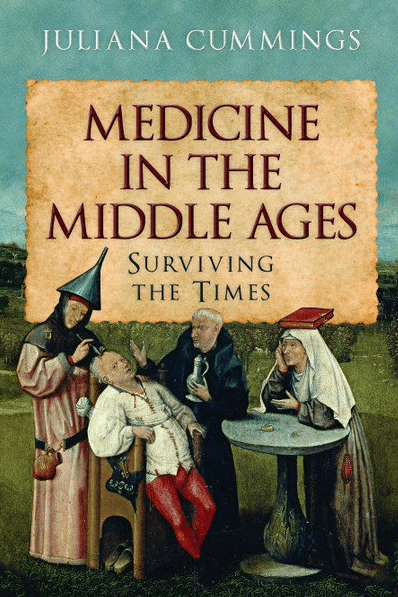Arpan K. Banerjee
Solihull, United Kingdom
 |
|
Cover of Medicine in the Middle Ages by Juliana Cummings. |
In the history of Western Europe, the Middle Ages refers to the period between the fall of the Roman Empire in the fifth century through the beginning of the Renaissance in the 1500s. These thousand years were characterized by unstable nation-states led by kings and nobility. Tribalism was rife, and societies were ravaged by war, invasions, and tribal migration, which made life difficult for the poor.
Religion played a great part in people’s lives. Most of the population lived in squalor and unsanitary conditions, which led to illness and infectious diseases. A stench was omnipresent in cities.
The era saw advances in agriculture, and trade became important with the development of market towns to facilitate the exchange of goods obtained from distant lands. This was a period in which universities were started and scholastic activities were encouraged, although the predominant influence was still religion, which sought to explain many of the ills that afflicted mankind as a punishment from God.
One can imagine medicine in this period as being primitive and influenced by dogma. In this interesting book, the author has set about telling the story of what life was like for people who lived during this time, especially the diseases they suffered and how they were treated.
The influences of Galen and Hippocrates were paramount in training. Medicine was not based on science as it is today, but influenced by religion, astronomy, alchemy, and superstition. Galen’s understanding of medicine was based on the theory of humors. This had been passed down from Hippocrates, who believed that four humors represented the four major liquids in the body: yellow bile, black bile, blood, and phlegm. It was believed that diseases arose from an imbalance of these four humors.
During the Middle Ages, Avicenna was considered one of the great pioneers of the Islamic golden age of medicine. He wrote his famous Canon, which covered medical, therapeutic, and diagnostic knowledge of the time. His influential ideas eventually spread to the West and his works were translated into Latin.
In the Middle Ages, the Church and monasteries played an important part in healing and looking after the sick. In the late medieval period, early teaching hospitals were founded in cities such as London, Paris, and Padua for medical education.
Cholera, dysentery, consumption, smallpox, and the sweating sickness were common. People believed these illnesses arose from miasma, or bad air from the prevalent stench of poor sanitation.
In the late Middle Ages, plague decimated most of Western Europe, a disease well chronicled by the Italian writer Boccaccio in his Decameron.
Mental illness was thought to be caused by possession and exorcism was practiced widely. Many illnesses such as syphilis were thought to be a punishment from God for debauchery.
The Middle Ages saw few advances in scientific surgery. John of Ardenne in the fourteenth century pioneered the use of anesthetic agents and early operations for pilonidal sinus and is considered one of the early founding fathers of British surgery. Childbirth remained a dangerous activity, with many women suffering from sepsis.
This book is an interesting read and gives us a fascinating insight into medical practice and the life and times of people in the Middle Ages. The widespread hardships and suffering of common men and women are vividly described and make us appreciate the magnificent scientific and medical advances that occurred in subsequent centuries, enabling us today to have excellent, advanced medical care and healthier lives. In the twenty-first century, this often goes unappreciated.
Medicine in the Middle Ages
Juliana Cummings
Pen and Sword Books Ltd UK
ISBN 9781526779342
ARPAN K. BANERJEE, MBBS (LOND), FRCP, FRCR, FBIR, qualified in medicine at St. Thomas’s Hospital Medical School, London. He was a consultant radiologist in Birmingham from 1995–2019. He served on the scientific committee of the Royal College of Radiologists 2012–2016. He was Chairman of the British Society for the History of Radiology from 2012–2017. He is Chairman of ISHRAD and adviser to Radiopaedia. He is the author/co-author of numerous papers and articles on a variety of clinical medical, radiological, and medical historical topics and seven books, including Classic Papers in Modern Diagnostic Radiology (2005) and The History of Radiology (OUP 2013).
Fall 2021 | Sections | Books & Reviews

Leave a Reply